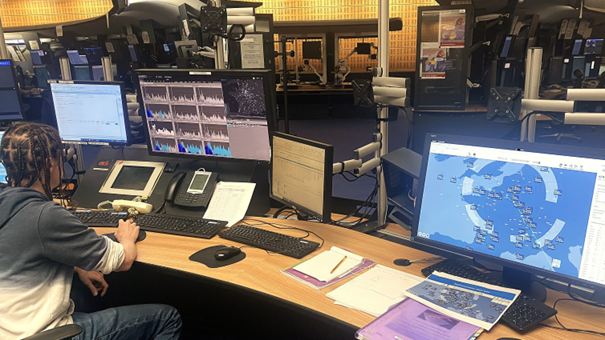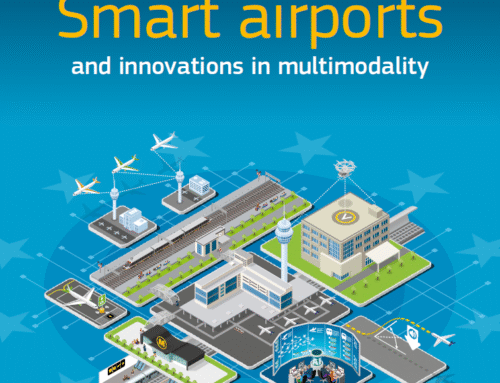ADS-C, or Automatic Dependent Surveillance-Contract, allows aircraft to automatically transmit on board data coming from their Flight Management System (FMS) to ground ATC systems. ADS-C data offer air traffic management an enormous potential of uses, for the benefit of air traffic controller situational awareness as they can access to actual intensions of each flight.
As part of the SESAR Joint Undertaking‘s HERON project, two successful demonstrations led by DSNA have tested the integration of ADS-C/EPP data into air traffic control systems and air traffic controllers working method. The two live trials were hosted at the Area Control Centres (ACC) of Paris and Marseille and ran with live traffic, offering valuable insights into the operational benefits of this innovative technology.
Solution 353 – ADS-C usage to support Flight Management Position (FMP) decision making
Already commonly used by busy airports within Europe as part of their collaborative decision making (CDM) processes, E-AMAN (Extended arrival manager) allows FMP controller for the sequencing of traffic in preparation for landing much earlier before the flights entering Terminal control Area (TMA) or extended TMA area, by extending the AMAN horizon, from the airspace around the airport to neighbouring en-route airspaces, to instruct pilots aircraft speed reduction (or acceleration) before beginning descent, thereby reducing the need for holding in TMA or the need for complex radar vectoring.
Key ADS-C/EPP data used during this live trial were the detailed estimates on each future waypoint along the trajectory and the speeds schedule for each flight phase, and the integration of this information in the Paris ACC local Flight Management Position’s working method.
Key highlights of the demonstration were:
- On the operational side: ADS-C data eases application of E-AMAN measures.
FMP controller can use ADS-C data to enhance his situational awareness and monitor speed reduction applied. The potential of ADS-C/EPP to improve traffic management in daily operation was demonstrated.
- On the technical side: platform integration with ADS-C common service.
The ADS-C common service used in the live trial was developed by Airtel ATN in line with the latest specifications. It was deployed with the support of Airtel ATN and EUROCONTROL and connected to the ground system via SWIM.
Solution 354 – Procedural facilitation of improved vertical profile based on display of ADS C information
This DSNA live trial focused on the optimisation of initial descent phase.
Key ADS-C/EPP data used during the DSNA demonstration were the detailed estimates on each future waypoint along the trajectory, and specifically the onboard calculated top of descent (TOD), plus the speeds schedule for each flight phase. The live trial studied the integration of this new information in the controller’s working method.
Key highlights of the demonstration were:
- On the operational side: ADS-C data supports application of green operations.
ATC controllers can check the aircraft trajectory consistency with ground ATC constraints and use onboard calculated TOD to issue descent clearance and monitor green operations during initial descent.
- On the technical side: platform integration with ADS-C common service as described hereabove for the previous exercise.
The potential of ADS-C/EPP to improve environmental performance in daily operation was demonstrated. The integration of these data on the FMP controller working position and on the air traffic controller working position marks an important step towards modernising air traffic management.
HERON live trials used prototypes which will pave the way for implementation in Air Traffic Management systems
- An intermediate upgrade of the E-AMAN tool already used by the FMP controller in Paris ACC.
There are plans to industrialise and deploy the supply of ADS-C/EPP data to the FMP controller in the coming months.
- A secondary screen of the controller working position to display ADS-C data.
Still with this secondary screen, further trials should take place in the coming months (no more in the HERON programme framework) to confirm the observed results against different destination airports and airspace configurations and to refine all stakeholders working method. Next step will consist in the integration of these ADS-C data on the controller main radar screen.
The HERON project is part of the broader SESAR JU initiative to modernise and green European aviation. Led by Airbus, HERON brings together 26 partners from 11 countries, with support from 6 airlines, 8 air navigation service providers and 5 airports. The project is carrying out a series of high-impact developments and demonstrations to reduce noise, fuel consumption, flight delays and CO₂ emissions.
More about the project.
Read more about the solutions.




